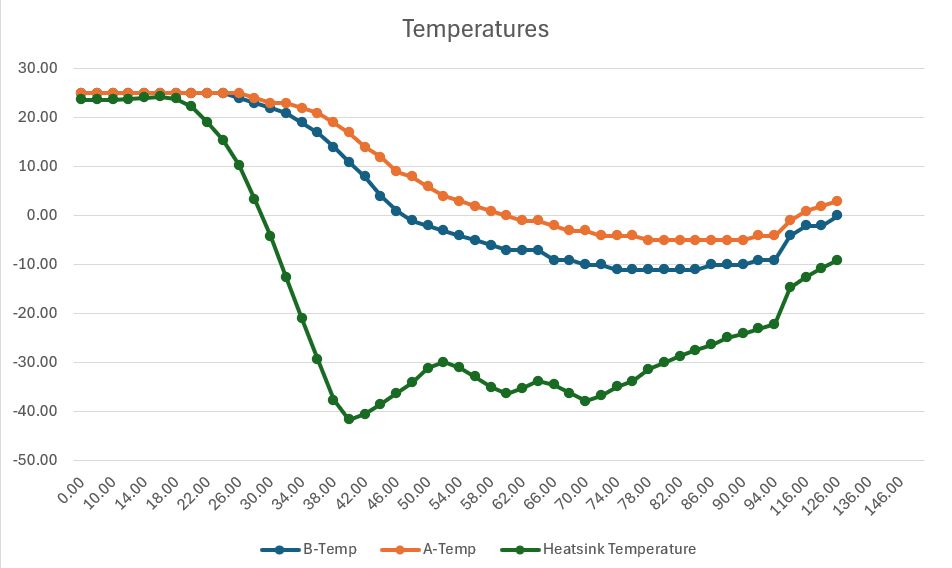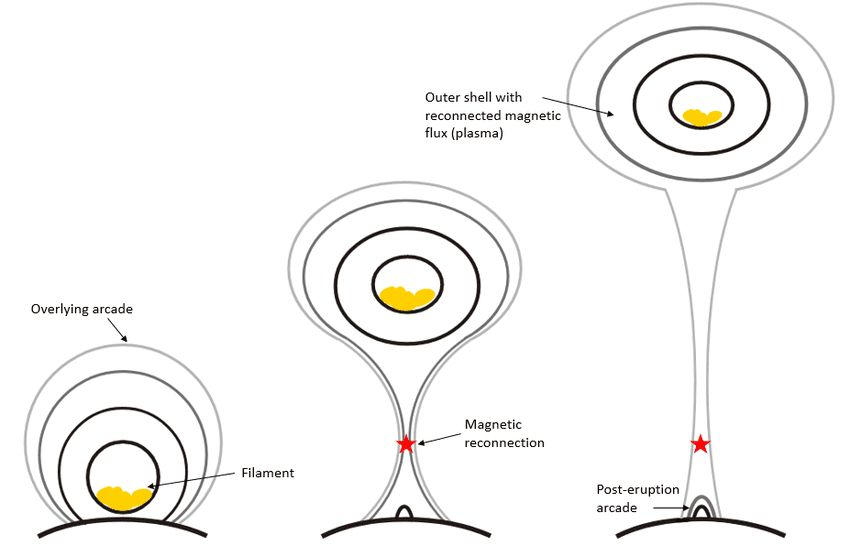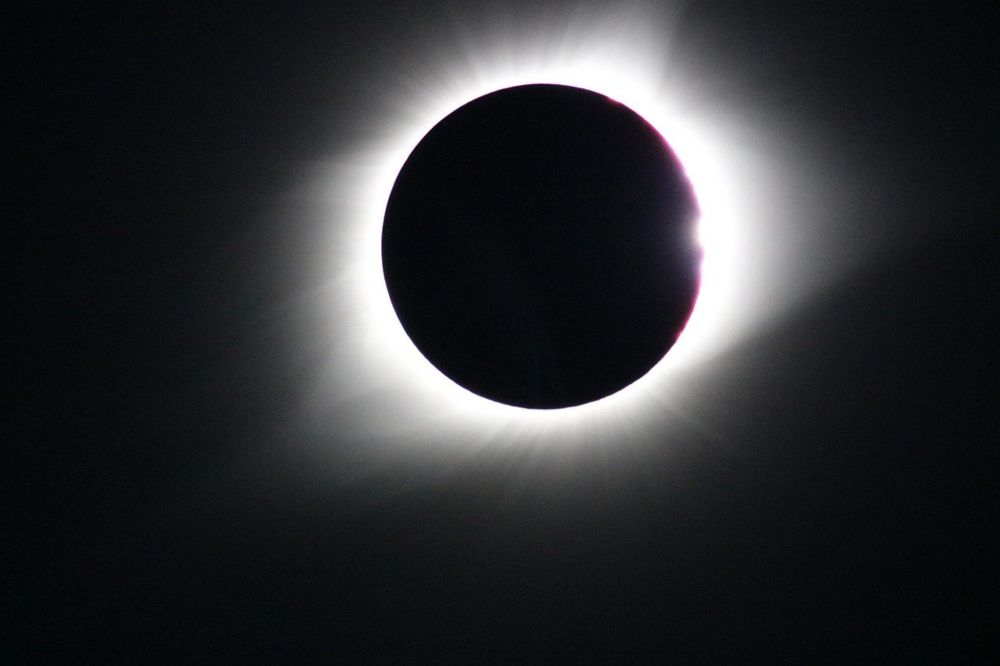We launched at 1pm MDT and the apogee height was about 350 km, which was much higher than expected. We got about 8 minutes of good solar data.
19.07.2025 03:33 — 👍 1 🔁 0 💬 1 📌 0
Payload was recovered, and looks in good shape (plus some extra mud)! We are going to pack things up and will be driving it back to Boulder soon, where the work of offloading the data and examining it will start.
18.07.2025 22:09 — 👍 3 🔁 0 💬 0 📌 0
Payload on the ground. Starting recovery now.
18.07.2025 19:18 — 👍 1 🔁 0 💬 1 📌 0
Good flight! We were on target, and have seen suggestion of capturing good data. Chute has deployed, will be landing soon.
18.07.2025 19:12 — 👍 2 🔁 0 💬 0 📌 0
Good launch! We are on our decent and will be landing shortly.
18.07.2025 19:08 — 👍 4 🔁 0 💬 1 📌 0
T-00:54:00
We have armed the rocket and raised it to vertical. Cooling has started, and we are now running vertical tests.
18.07.2025 18:06 — 👍 0 🔁 0 💬 0 📌 0
T-02:05:00
At this time we have stopped and detached our vacuum pump and powered down the payload so the rocket can be armed. The payload will now hold vacuum unassisted until launch.
18.07.2025 16:56 — 👍 0 🔁 0 💬 0 📌 0
Horizontal checks complete! We are at T-04:20:00. Next up, we will detach the vacuum pump from the payload and start preliminary arming of the rocket.
18.07.2025 14:40 — 👍 0 🔁 0 💬 0 📌 0
Launch day! We are at T-04:45:00 and on track for our 1PM launch. Right now we are running through checks that will continue up until launch, making sure all our systems are functional.
18.07.2025 14:15 — 👍 0 🔁 0 💬 0 📌 0
See alt text for more info! (3/3)
17.07.2025 20:05 — 👍 0 🔁 0 💬 0 📌 0
Detector A is warmer than B due to the longer copper heat strap that connects it to the heatsink. The added length slows the heat transfer, causing it to lag behind B. This plot shows that it took about 1 hour to cool both detectors down to below 0 deg C, which is our target for launch! (2/3)
17.07.2025 20:05 — 👍 0 🔁 0 💬 1 📌 0

A graph titled "temperatures." The x-axis is time, in mins and spans from 0 to 146. The y-axis is temperature, in degs C, and spans from 30 to -50. The graph has three colored lines on it, indicating the temperature of detector A, B and the heatsink.
All three lines are roughly flat until +24 mins when the heatsink starts to experience cooling at a rate of -2.46 deg C/min. At roughly 42 mins, cooling stopped and the heatsink temperature started to rise. From that point onwards the heatsink temperature slowly oscillates around -35C as we toggle on and off the cooling.
Both detectors start showing a drop from their starting 25C at 26mins, and cool with a far lower slope (-0.246 C/min). Detector A is about 3C to 8C warmer than B at all times, due to its longer heat strap. Both detectors reach the target of 0C at 60mins.
Data from today's cooling test. Along the y-axis is temperature (in degrees C) and the x-axis is time (in minutes) counting up from the start of the test. The heatsink (green) which is directly cooled by the liquid nitrogen cools quickly, while the two detectors (blue and orange) cool slower. (1/3)
17.07.2025 20:05 — 👍 0 🔁 0 💬 1 📌 0
We have successfully completed horizontal and vertical checks, running through 12 minute countdowns with the rocket horizontal, before raising the rail to vertical and running another count. As part of these checks, we also tested our cooling system, tracking our temperature responses.
17.07.2025 16:55 — 👍 0 🔁 0 💬 0 📌 0
SNIFS is in the news!
Daily Camera, Boulder CO: www.dailycamera.com/2025/07/17/n...
Longmont Times Call, Longmont CO: www.timescall.com/2025/07/17/n...
The Indian Express, India: indianexpress.com/article/tech...
17.07.2025 14:36 — 👍 0 🔁 0 💬 0 📌 0
Day two of pre-launch testing! We are going to run through the countdown again to make sure everything is ready for launch tomorrow!
17.07.2025 14:35 — 👍 0 🔁 0 💬 0 📌 0
Testing continues out at white sands. We just raised the launch rail and rocket up to vertical for the first time in preparation for a dry run. During this run, we will walk through the pre-launch sequence and simulate launch to make sure all systems are go.
16.07.2025 18:03 — 👍 0 🔁 0 💬 0 📌 0
We are on the launch rail! This morning we drove the payload down and attached it to the rail and two stage rocket that will launch us into space in just a few days. Right now the rail is horizontal, and will remain that way as we run tests to make sure everything is working as expected.
15.07.2025 20:03 — 👍 0 🔁 0 💬 0 📌 0
When we reach T-0 we “launch” by disconnecting all the umbilical cables, switching the payload to internal power and wireless communications. Sequence tests make sure that all the parts of the #rocket are working as they should, and gives the team a chance to practice for the actual launch (2/2)
13.07.2025 02:00 — 👍 0 🔁 0 💬 0 📌 0
We recently completed a sequence test. During these tests, we simulate #launch and the actions leading up to it. We start at T-720 seconds, and count down, performing all the tasks we would during the real flight, such as checking we are receiving data and telemetry and sending commands. (1/2)
13.07.2025 02:00 — 👍 0 🔁 0 💬 1 📌 0
Remember the impressive #aurora at low latitudes during May 2024? These were caused by multiple CMEs which went toward Earth. In addition to the aurora those solar storms caused some damage to satellites, though space forecasting allowed us to shut them down beforehand and avoid the worst damage
9/9
12.07.2025 17:10 — 👍 0 🔁 0 💬 0 📌 0
If that bubble intersects with the Earth, it can damage spacecraft, increase radiation to dangerous levels for astronauts and planes flying over the poles, cause radio communications blackouts, and cause beautiful aurora.
8/n
12.07.2025 17:08 — 👍 0 🔁 0 💬 1 📌 0

A diagram showing a CME at 3 stages of evolution.
The first shows the surface of the sun with a filament containing plasma. Magnetic loops surround it.
The second shows that the filament of plasma has moved upwards and the surrounding loops are bowing inward where they're stretched out underneath, looking almost like a balloon or inverted water droplet. The point where the loops almost touch is marked with a red star labeled "Magnetic Reconnection".
The third stage shows the bubble of fillament plasma has moved up and away from the sun and is labeled "outer shell with reconnected magnetic flux plasma". The loops stretching back downwards are greyed out and very long now. Below them we see a few small arches of magnetic field labeled "post eruption arcade"
In the image below, we see that the upper legs of the magnetic loops are full of plasma. When reconnection happens, the upper legs connect to each other and form a bubble of hot plasma. The energy release shoots that bubble out from the Sun and into the solar system.
7/n
12.07.2025 17:08 — 👍 1 🔁 0 💬 1 📌 0
energy release will cause the nearby plasma to heat up explosively and glow in x-ray wavelengths, which we perceive as a solar flare!
A solar flare may also be accompanied by a bubble of plasma which is expelled out of the Sun's atmosphere at high speeds.
6/n
12.07.2025 17:04 — 👍 0 🔁 0 💬 1 📌 0
a magnetic south component) will detatch from the upper part of the legs and connect to each other instead. The top parts of the legs will do the same. At that point, the tension is released and the field lines will snap back like a rubber band, releasing a lot of energy. This sudden intense
5/n
12.07.2025 17:03 — 👍 0 🔁 0 💬 1 📌 0
different speeds. This causes the loops, which are anchored in the surface, to get stretched out like a rubber band and twisted. If the two legs of the loop touch each other, reconnection will occur, where the two bottom parts of the legs (one with a magnetic north component and the other with
4/n
12.07.2025 17:03 — 👍 0 🔁 0 💬 1 📌 0
Solar flares are large explosions in the Sun's atmosphere caused by magnetic reconnection. The sun has a number of magnetic field loops that stick out of its surface, similar to the pictures you've seen of magnets. Because the Sun is a fluid and not a solid, different latitudes rotate at
3/n
12.07.2025 17:02 — 👍 0 🔁 0 💬 1 📌 0
Solar storms are events on the Sun which cause major effects in the solar system. This most commonly is from one of 3 sources: a solar flare, a coronal mass ejection (CME), or a solar particle event. These all have potential impacts on satellites, astronauts, and communications. 2/n
12.07.2025 17:01 — 👍 0 🔁 0 💬 1 📌 0
While our it's not in our #science requirements that we need to see a solar flare, we'd certainly take the opportunity to observe one if it happened during our flight, since they have a potential to affect space weather around Earth.
#Solar #RocketLaunch #Heliophysics #Space #Sun
12.07.2025 16:59 — 👍 1 🔁 0 💬 1 📌 0



